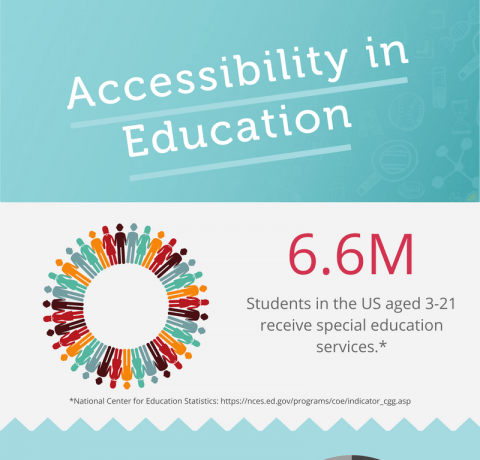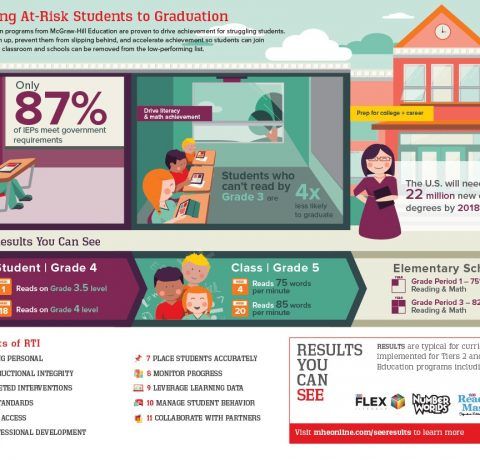Anatomy of a Special Needs Child Infographic
The Anatomy of a Special Needs Child Infographic provides useful information and tips on raising the four major types of special needs children.
Major Types of Special Needs Children
- Physical: Muscular Dystrophy, Multiple Sclerosis, Chronic Asthma, Epilepsy, etc.
- Developmental: Down syndrome, autism, dyslexia, processing disorders.
- Behavioral/Emotional: ADD, Bipolarism, Oppositional Defiance Disorder
- Sensory impaired: Blind, visually impaired, deaf, limited hearing.
How to identify and care for special needs children
1. The IDEA Act (Individuals with Disabilities Education Act):
- Students with disabilities must be prepared for further education, employment, and independant living.
- If a child's strength, endurance, or stamina cannot keep up with school activities, they can qualify for "other health impaired" special education status.
2. Section 504 of the Rehabilition Act
- Prohibits schools from disriminating against children with disabilities.
- Requires schools to provide accomodations for disabled students.
- Students with impairments that substaintally limit a major life activity can qualify as disabled (learning and social development deficits too).
3. Americans with Disabilities Act(ADA)
- Schools must meet the needs of children with psychiatric problems.
- No Child Left Behind
- Schools must uphold achievement standards for children with disabilities.
Core Concepts
IEP (Individualized Education Program) is a legally binding document spelling out what special education services your child will recieve and why.Includes classification and accomodations.
- Classification: One of 13 different disability classes that qualify for special education services. Including: visual impairment, speech and language impairment, auditory impairment. deaf/blind, autism, developmental disabilities, multiple disabilities, orthopedic impairment, specific learning disabilities, emotional/behavioral disorder, traumatic brain injury, multi-sensory impairment, and serious health impairment.
- Accomodations: a change in timing, presentation, formatting, setting, etc. that will allow the student to complete normal classwork.
- Modification: an adjustment to an assignment that a special needs child is not expected to complete at a normal level.
Types of Special Needs
Special Physical Needs:
- Allergies and Asthma
- Juvinile Arthritis
- Luekemia: Very rare
- Muscular Dystrophy
- Sight Impaired
- Multiple Sclerosis
- Hearing Impaired
Tips for dealing with medical needs
See if your child qualifies for "other health impaired" placement in special ed. Other health impaired (according to Federal regulation) includes children who have "limited strength, vitality, or alertness, including to environmental stimuli."
Allergies and Asthma: Are the same in children as in adults, only children have less maturity and emotional resources than adults to deal with them.
Tips:
- Explain to children what they are allergic to.
- Alert school personel as to the conditions and provide medicines.
- Work with school personel to make accomodations.
- Substitute another activity for recess on high pollen count days.
- Make sure that caretakers schedule sympton inducing activities around when a child will be in the area.
- Tailor coursework to provide emotional and explanatory support for the child's condition.
Juvinile Arthritis:
- Education is often interrupted during long "flare-ups" of juvinile arthritis. Here's what you can do to promote healthy development.
- Establish an IEP or 504 plan with educators to ensure that your child's rights are protected.
The IDEA act (Individuals with Disabilities Education Act) outlines a special needs child's rights in education. - If the students strength, endurance, or stamina is affected obtain a note from a physician to see if your child qualifies for special education under "other health impaired."
- Contact the hospital or homebound coordinator for your district if your child is frequently missing large periods of school.
- Frequent communication between parents and teacher ensures the teacher knows the student's current medical status and can adapt lessons accordingly.
Proper ergonomics in the classroom are particularly important for children with Juvinile diabetes
Luekemia: The five year survival rate for Luekemia is 60%-80%. Over such a prolonged period key emotional and cognitive developmental stages may be reached.
Key factors:
- Limit pain
- Emotional support helps with development
- Mental engagement is important so that recovering children don't fall massively behind.
Muscular Dystrophy
- Ensure your child is being worked with by assistive technologist, occupational therapist, and school psychologist.
- Make sure that teachers understand that fatigue, clumsy or slow movement, or slurred words are health issues, not behavioral issues.
- Remember your child is still a child with normal interests and dreams.
Sight impaired: Seek out an assistive technologist if impairment persists after help from an eye doctor. It's hard to learn if you can't see!
Hearing impaired: Seek out ENT's and assistive technologists to help your child. It's hard to learn if you can't hear!
Special developmental needs: Many developmental delays can be spotted in a child's first year of life. Children develop at different rates, but these are the rough ages a child should reach certain milestones.
Motor skills
3 months:
- Lift head and chest when on stomach
- Follow people and moving objects with eyes
- Grasp rattle when given to her.
6 months:
- Reach for and grasp for objects
- Roll over
- Sit with little support
12 months:
- Drink from cup with help
- Crawl
- Walk with help
Sensory and thinking skills
3 months:
- Recognize bottle or breast
- Turn head to bright colors or sound of human voice
6 months:
- Imitate familiar actions.
- Open mouth for spoon.
12 months:
- Try to accomplish simple goals.
- Copy sounds and actions you make.
Language and social skills
3 months:
- Communicate fear, hunger, or discomfort.
- Smile when smiled at.
6 months:
- Smile at self in mirror.
- Know familiar faces.
- Babble. Sing-song noises.
12 months:
- Try to "talk" with you.
- Understand simple commands.
- Show apprehension at strangers, affection to familiar adults.
Tips for dealing with Special Developmental Needs
Autism: Autism spectrum disorder ranges from mild lack of social understanding, to non-verbal
Early signs:
- Not responding to name by 12 months.
- Delayed speech and language skills.
- Avoiding eye contact.
- Upset with small changes in routine.
Tips:
- Get a evaluation as early as possible.
- Utilize school psychologist, and occupational therapist.
- Create a "safe" zone where the child can be alone and relax at home.
- Pay attention to child's hypersensitivities.
Dyslexia: Dyslexia is very taxing, taking at least 5% more energy to process basic tasks. Those with dyslexia have much to offer, however, with dyslexia sufferers often being above average IQ and highly creative.
Early Signs:
- Appears bright, but unable to read at grade level.
- Tests well orally, but not on written tests.
- Seems to "daydream" a lot.
Tips:
- Read advanced material. This engages both sides of the brain.
- Don't stress the misreading of "little" words (in, i'm, none, he). They will outgrow such mistakes.
- Discussion, discussion, discussion.
Many students with developmental delays are actually very gifted. Don't stress the little mistakes, let them show you what they can do.
Special Behavioral/Emotional Needs
Students with behavioral/emotional needs are more than capable of learning, but their disabilities need management so they don't distract themselves or the entire class.
- Obsessive Compulsive Disorder
- PTSD
- Anxiety Disorders
Overall tips:
- Learn more about your students specific illness, what caused it, what type of therapy they're attending, and so on.
- Learn about the student's strengths. Pull these out. Positive reinforcement works.
- Set very clear behavioral rules on the entire class.
Support the inclusion of all types of children and celebrate their talents. Most of all, don't forget they're just kids.







You can adjust your cookie preferences here.